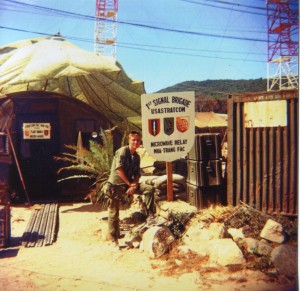The first shipload of remains of Americans killed in Korea arrived in Japan on 3 January 1951. By the end of January almost 5,000 bodies had been removed from military cemeteries in South Korea, including the Inchon, Taejon, Taegu No. 1 and No. 2, Masan, and Miryang Cemeteries. The process of identifying the bodies began soon after they arrived. The remains of the fallen soldiers were reverently placed in mausoleums at Camp Kokura, site of a former Japanese Officers Barracks, on the northern tip of Kyushu. The Quartermaster of the Far East Command, later Quartermaster General, MG K. L. Hastings, had made a decision, approved by the Defense Department, to return all American casualties to the United States rather than establish permanent cemeteries in Korea. This policy of Concurrent Return is still in place; no longer would American soldiers rest on foreign soil. LTC John Cook, Quartermaster Corps, was quoted in the Quartermaster Review in 1953: “Never in the history of the United States or any other nation, has there been a mass evacuation of the remains of men killed in action while hostilities were still in force. This departure from the long established practice of leaving remains in battlefield cemeteries or isolated locations until after the cessation of hostilities necessitated the activation of an organization capable of carrying out the manifold operations of receiving, processing, identifying embalming, casketing and shipping.”
The Field Operation Section, 8204th Army Unit (Army Graves Registration Service Group), a unit of approximately two hundred men, under the leadership of CPT William P. Russell, was assigned the task of preparing, not only the disinterred remains from temporary burial grounds in Korea, but all of the war dead, which from that time forward were sent directly to Camp Kokura from the battlefield. The actual work of identifying, embalming, dressing, and placing the bodies in caskets in preparation for being sent back to their loved ones, was carried out at warehouses several miles away.
The fallen soldiers arrived aboard Landing Ship Tanks (LST) or C-47 Dakota transport aircraft. LSTs would circle the waters of Moji Port, near Camp Kokura, until the sight of Army trucks pulling up to the dock signaled for them to land. During the next two days, as many as 800 bodies were unloaded with dignity and respect, placed in the trucks and transported to the buildings where the processing took place.
The first step was identification. The Central Identification Laboratory, consisting of civilian and military technicians trained at Fort Lee, Virginia, examined the remains for physical characteristics such as fingerprints, teeth, hair color, skin pigmentation, height, tattoos, scars, shoe size, and bone and cranial formations in order to gather enough information to insure absolute identification. Dentures, which were sometimes inscribed with the man’s name or serial number, were examined. Clothing was inspected using infrared photography to bring out faded laundry marks or serial numbers. Physical anthropologists could determine the individual’s race and age. It was not unusual for several partial sets of remains to be received at Camp Kokura in one body bag. The challenge for the identification team was to separate the remains and to determine without question the identity of each individual fallen soldier. According to a report written in 1954 by COL John D. Martz, Jr., QMC, who commanded the 8204th during two and a half years of the Korean conflict, “On many occasions, live grenades and small arms munitions were found when the clothing was removed. In some cases the firing-pin releases were badly rusted and in momentary danger of breaking and activating the grenades.”
The second phase of the process, embalming and preserving the remains for shipment home, was not started until the identity of the fallen soldier was determined beyond a doubt. The Army considered the correct identification of remains critical. They went to extreme measures to ensure that no mistakes were made. On one occasion it was discovered that the wrong body had been sent home to Texas. The train out of San Francisco, where the body of a dead soldier had been put ashore, was stopped. The remains, along with the assigned military escort, were removed and held in a railway station under Army guard while a plane was dispatched from Japan with the correct body. The exchange was made and the train carried the soldier on his way to be reunited with his loved ones, who never knew of the mix-up. According to Robert Emmet Cassidy, an embalming specialist with the 8204th, the idea of one airplane to carry one body was unprecedented. “It showed how much the Army cared; how important it was to them that the folks at home knew for sure that the body in the casket was really their son.”
The men of the 8204th who worked in three person teams in the embalming and preservation section were handpicked for their experience in mortuary service. The men worked long hours under difficult circumstances. Although they wore special clothing and respiratory masks and the laboratory was equipped with up to date (for the 1950s) down draft exhaust systems around each mortuary table, the mental and emotional aspects of handling the remains required special attention. The attitude of the commanding officers was critical. The remains were to be treated with the honor due to any fallen hero who gave his life to save someone else. The dead soldiers and their families deserved the respect and the best care the Army could give them.
The team members were advised not to personalize the remains, not to wonder who the person was or how he was killed, but only to recognize that he gave his life for his country and was truly a hero. The men were encouraged to leave the base in their free time and to use the recreational facilities at Camp Kokura to give them a break from dealing at close range with the monstrous effects of war. Chaplains were constantly available to help. If it was deemed necessary by the commanding officer, men were moved around to different jobs, temporarily or permanently, to help them maintain their emotional equilibrium.
Dressing the bodies or partial remains and placing them in the caskets with identifying labels was the third step. Many of the combat causalities started home from Japan within a period of thirty days from the date of death in Korea. The chaplain, a permanent member of the staff at the 8204th headquarters, joined by other chaplains from nearby installations representing all major denominations, conducted weekly memorial services in the mausoleum area. A solemn military ceremony was conducted at dockside to mark departure of the caskets for the United States. As the returning heroes in flag draped caskets were hoisted onto the ship, a military band played and members of the 8204th saluted. The men had completed their work and fallen comrades were on the way home to their families.
After hearing about a battle in which many American lives were lost, Japanese civilians employed at the base frequently showed up at work with flowers to show their concern and appreciation for the American soldiers that had given their lives. They were fully aware of the benefits their country received through the sacrifices of Americans. Children hovered around the gates of Camp Kokura hoping to engage the men of the 8204th in English conversation. The men expressed mutual respect for the Japanese citizens by sponsoring social events, including an American Christmas party, for children from a nearby orphanage.
On 24 February 1955 President Dwight David Eisenhower awarded a Meritorious Unit Citation to the 8204th “as public evidence of deserved honor and distinction.” The citation reads: “The American Graves Registration Group, 8204th Army Unit, is cited for the exceptionally meritorious conduct in the performance of outstanding services in support of combat operations in Korea…The unit’s exceptional skill, speed and accuracy in accomplishing its extremely sensitive operations were reflected in an accelerated, highly dignified program of return of war dead to their homelands. The professional competence, unity of effort, and meticulous attention to detail exhibited by each member of the American Graves Registration Group, 8204th Army Unit, contributed significantly to the success of their difficult and vital mission in support of the United Nations’ first armed bid for world peace and reflects great credit on themselves and the military service of the United States.”
After the cessation of hostilities in Korea, the Army inactivated Graves Registration units. The 8204th was inactivated in 1956.
Total death count from the Korean War was over 54,000. Approximately 8,100 soldiers are still missing, and today recovery operations continue.
Robert Emmett Cassidy reflects on his experiences with the unit. “Even today I have flashbacks in the middle of the night thinking of processing those fallen heroes from Korea. They gave it all up in order to save another member of the unit. I wake up in a cold sweat just thinking about the patriotism it took to give up your life in defense of our country. It was an overwhelming gift to all of us.”



